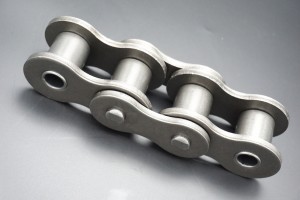When it comes to industrial machinery and power transmission systems, the importance of reliable components cannot be overstated. Among these components, roller chains play a vital role in ensuring smooth and efficient operation. One of the most widely recognized roller chain types is the ANSI Standard Heavy Duty Series roller chain. In this blog, we will delve into the intricacies of ANSI Standard Heavy Duty Series roller chain, exploring its design, applications, benefits and maintenance tips.
What is ANSI standard heavy-duty series roller chain?
The American National Standards Institute (ANSI) has developed a set of roller chain standards that are widely used in various industries. ANSI Standard Heavy Duty Series roller chains are specifically designed to handle higher loads and provide greater durability compared to standard roller chains. These chains feature rugged construction, including thicker side plates and larger pins, making them suitable for heavy-duty applications.
Key Features of ANSI Standard Heavy Duty Series Roller Chains
- Durability: Heavy-duty series roller chains are built to withstand extreme conditions, including high loads, shock loads and abrasive environments. Their construction materials and design ensure longevity and reliability.
- LOAD CAPACITY: ANSI Standard Heavy Duty Series Roller Chains are engineered to withstand significantly higher loads than standard chains. This makes them ideal for applications involving heavy machinery and equipment.
- VERSATILITY: These chains can be used in a wide range of applications, from manufacturing and construction to agriculture and mining. Their adaptability makes them a popular choice across a variety of industries.
- Standardized: ANSI compliance means these chains follow specific size and performance standards, ensuring compatibility with a variety of sprockets and other components.
Application of ANSI standard heavy-duty roller chain
ANSI Standard Heavy Duty Series Roller Chains are widely used in numerous applications in different sectors. Here are some common uses:
- Manufacturing: In manufacturing plants, heavy-duty series roller chains are commonly used in conveyor systems, assembly lines, and material handling equipment. Their ability to handle heavy loads makes them ideal for transporting goods and materials.
- Construction: Heavy machinery used in construction, such as excavators, bulldozers and cranes, often rely on ANSI standard heavy-duty series roller chains for power transmission. These chains can withstand the rigors of construction sites where heavy loads and harsh conditions are the norm.
- Agriculture: In the agricultural sector, heavy-duty series roller chains are used on a variety of equipment, including tractors, harvesters, and irrigation systems. Their durability ensures they can operate effectively in demanding environments.
- Mining: The mining industry requires rugged components that can handle extreme conditions. ANSI Standard Heavy Duty Series roller chains are commonly used on conveyor systems, crushers and other heavy machinery in mining operations.
Advantages of using ANSI standard heavy-duty series roller chain
- Improved Efficiency: The heavy-duty series roller chain is designed to operate more smoothly and reduce friction and wear. This improves power transmission efficiency and reduces energy consumption.
- REDUCED DOWNTIME: The durability of ANSI Standard Heavy Duty Series roller chains means they are less likely to fail, reducing downtime for maintenance and repairs. This is especially important in industries where time is money.
- Cost Effectiveness: While the initial investment in heavy-duty series roller chains may be higher than standard chains, their service life and reduced maintenance requirements often reduce overall costs in the long run.
- Safety: Reliable power transmission is critical to the safety of machinery operators and workers. ANSI Standard Heavy Duty Series roller chains provide a reliable solution that minimizes the risk of accidents due to chain failure.
Maintenance Tips for ANSI Standard Heavy-Duty Series Roller Chains
To ensure the longevity and optimal performance of ANSI Standard Heavy Duty Series roller chains, regular maintenance is essential. Here are some tips to remember:
- Periodic Inspections: Check the chain regularly for signs of wear, such as stretch, cracks, or deformation. Catching problems early can prevent more serious problems from occurring.
- Proper Lubrication: Lubrication is essential to reduce friction and wear. Use the appropriate lubricant recommended by the manufacturer and make sure the chain is well lubricated at all times.
- Alignment: Make sure the chain is properly aligned with the sprockets. Misalignment can cause uneven chain wear and premature failure.
- Tension Adjustment: Maintain the correct chain tension to prevent slipping and excessive wear. Follow the manufacturer’s tension adjustment guidelines.
- CLEAN: Keep the chain clean and free of debris, dirt and contaminants. Regular cleaning helps maintain the performance of your chain and extend its life.
in conclusion
ANSI Standard Heavy Duty Series roller chains are critical components in many industrial applications, offering durability, efficiency and reliability. Understanding its function, application and maintenance requirements is critical for anyone involved in operating or maintaining machinery. By investing in high-quality ANSI Standard Heavy-Duty Series Roller Chain and adhering to proper maintenance practices, businesses can ensure smooth operations and minimize downtime, ultimately increasing productivity and profitability.
In a world where machinery plays a key role in various industries, the importance of selecting the right components cannot be ignored. ANSI Standard Heavy Duty Series roller chains stand out as a robust solution for heavy-duty applications, making them the first choice for engineers and operators. Whether in manufacturing, construction, agriculture or mining, these chains are designed to meet the needs of modern industry, ensuring operations run smoothly and efficiently.
Post time: Nov-11-2024

